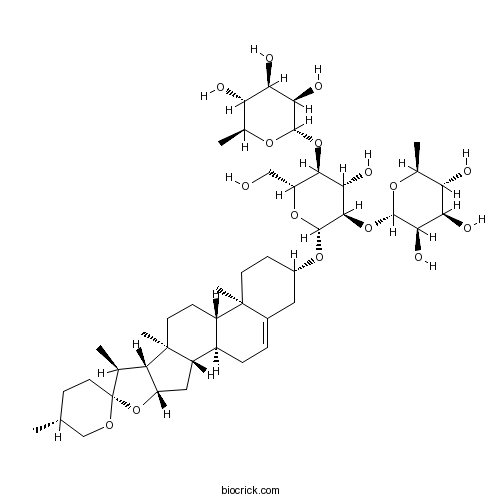A spirostanyl glycoside that consists of the trisaccharide α-L-Rha-(1→4)-[α-L-Rha-(1→2)]-β-D-Glc attached to position 3 of diosgenin via a glycosidic linkage.
InChI=1S/C45H72O16/c1-19-9-14-45(54-18-19)20(2)30-28(61-45)16-27-25-8-7-23-15-24(10-12-43(23,5)26(25)11-13-44(27,30)6)57-42-39(60-41-36(52)34(50)32(48)22(4)56-41)37(53)38(29(17-46)58-42)59-40-35(51)33(49)31(47)21(3)55-40/h7,19-22,24-42,46-53H,8-18H2,1-6H3/t19-,20+,21+,22+,24+,25-,26+,27+,28+,29-,30+,31+,32+,33-,34-,35-,36-,37+,38-,39-,40+,41+,42-,43+,44+,45-/m1/s1
Dioscin, a saponin extracted from the root of Polygonatum Zanlanscianense Pamp, can markedly inhibit proliferation of Hela cells, underwent apoptosis in dose- and time-dependent manner.[1]
Dioscin shows remarkable protective effect against acetaminophen-induced liver damage in vitro and in vivo by adjusting mitochondrial function.[2]
Dioscin induces generation of reactive oxygen species through mitochondria dysfunction, is capable of inducing apoptosis in mammalian cells, in which the mitochondria-initiated apoptosis pathway plays an important role.[3]
Dioscin can restore the activity of the anticancer agent adriamycin in multidrug-resistant human leukemia K562/adriamycin cells by down-regulating MDR1 via a mechanism involving NF-κB signaling inhibition.[4]
Dioscin shows little inhibition activity of tyrosinase, whereas oxyresveratrol, a known tyrosinase inhibitor, shows a strong tyrosinase inhibitory activity , and a mixture of oxyresveratrol and dioscin (IC50 = 5.1 and 5.7 μg/ml) highly increases the inhibition of tyrosinase activity with l-tyrosine or l-DOPA as the substrate as compared to either oxyresveratrol (IC50 = 7.8 and 10.9 μg/ml) or dioscin (IC50 > 100 and 100 μg/ml) alone.[5]
Dioscin has been shown to promote anticancer activity against several forms of cancers, it induces apoptosis in cancer cells through the induction of oxidative stress, peroxiredoxins 1and 6 (PRDX 1 and 6) are key targets in the process of dioscin-induced apoptosis that involves intracellular elevated ROS.[6]
Rhizoma Dioscoreae septemlobae (RDSE) and its main component dioscin (DIS) display a weak xanthine oxidase (XO) inhibition activity compared with allopurinol, therefore, they processed uricosuric and nephroprotective actions by regulation of mOAT1, mURAT1 and mOCT2.[7]
[1] Cai J, Liu M, Wang Z, et al. Biol Pharml Bull, 2002, 25(2):193-6.
[2] Zhao X, Cong X, Zheng L, et al. Toxicol Lett, 2012, 214(1):69-80.
[3] Wang Y, Che C M, Chiu J F, et al. J Proteome Res, 2007, 6(12):4703-10.
[4] Wang L, Meng Q, Wang C, et al. J Nat Prod, 2013, 76(5):909-14.
[5] Liang C, Lim J H, Kim S H, et al. Food Chem, 2012, 134(2):1146-8.
[6] Wang Z, Cheng Y, Wang N, et al. Cancer Biol Ther, 2012, 13(3):138-47.
[7] Su J, Wei Y, Liu M, et al. Arch Pharm Res, 2014, 37(10):1336-44.
[8] Dong-Xiang L I, Qing L I, Guan X Y, et al. Chinese J Pharm Anal, 2012, 32(4):596-8.



